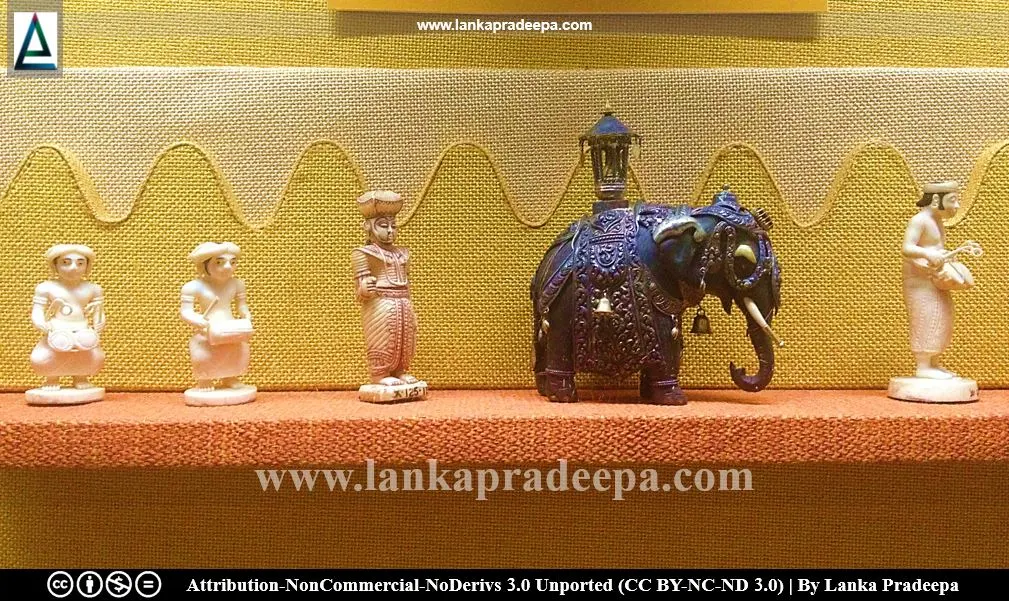
|
Ivory images pertaining to the Buddhist Perahera (18th century) |
National Museum of Kandy, Sri Lanka is one of the Museums Administered by the Department of National Museums. Presently, the museum has a large collection of artefacts (approximately 4000 items) mainly representing the subject areas of history and ethnology of the Kandyan Period.
History
The museum was established in 1942 in an old building called Palle Vahala (Embuldeniya & Karunarathna, 2019; Rambukwella, 2014). During the reign of King Sri Vickrama Rajasingha (1798 -1815 A.D.), this building was used as the harem or the quarters of his royal queens (Embuldeniya & Karunarathna, 2019; Rajapakse, 2016).
The first collection of artefacts deposited in the Kandy museum belonged to Mr. John Andy Dickson, the Government Agent for Kandy who served the British government in 1832. He had a large number of antiques mainly collected from Kandy and Matale Districts in his residence and most of them were artifacts belonging to the subject of ethnology. On retirement, he donated this collection of artefacts to the Kandyan Art Association. The re-donation of these artefacts by the Kandyan Art Association became the basis of the establishment of the present Kandy Museum.
The museum was declared open to the public on 27 August 1942, by a Gazette notification published under Gazette No. 11.20.97.37.
The Museum Building
The building has been built according to the architectural traditions of the Kandyan Period (Embuldeniya & Karunarathna, 2019). The attractive large roof, centre courtyard and windows, stone-paved floor, lime-plastered walls, and large doorways can be identified as the main architectural features of this building.
Artefacts
The museum is used to display artefacts, mostly pertaining to the Kandy Period and the Kandy region (Rambukwella, 2014). They include various types of textiles, household items, ornaments, arms and armaments, brass, bronze and iron implements, Dutch and English coins and other items, Buddhist statues and decorative wood carvings, ivory and metal objects, wall paintings, panels and coins (Rambukwella, 2014). The majority of these artifacts are from the 18th and 19th centuries A.D. (Rambukwella, 2014).
The Crown of King Rajasinghe II (replica)
The original crown of King Rajasinghe II (1635-1687 A.D.) has been exhibited in this museum since its establishment, but the crown was stolen in 1961.
The replica (in the left photograph) was made akin, out of copper and gold gilt in 1972, on the order of William Gopallawa, the then president of Sri Lanka. Several parts belonging to the original crown have also been added to this replica.


Related Posts
Read Also
References
Books, Journal Articles
1) Embuldeniya, P., Karunarathna, K.G.M., 2019. Significance of developing museums in Sri Lanka as tourist attractions: with special reference to national museums. EPRA International Journal of Research and Development. Vol. IV. Issue 2. pp.14-21.
2) Rajapakse, S., 2016. Pauranika Sthana Ha Smaraka: Mahanuwara Distrikkaya (In Sinhala). Archaeological Department of Sri Lanka. ISBN:955-9159-34-8. p.39.
3) Rambukwella, M.W.C.N.K., 2014. Heritage representation in culturally diverse societies: a case study of the Colombo National Museum in Sri Lanka (Doctoral dissertation, School of Museum Studies). pp.401-402.


